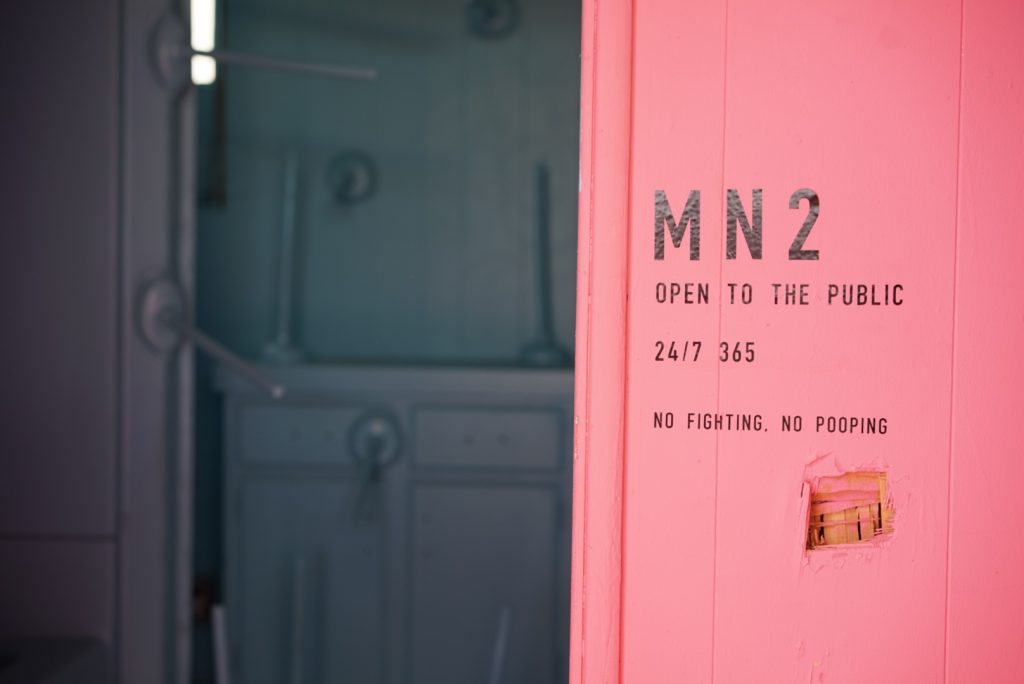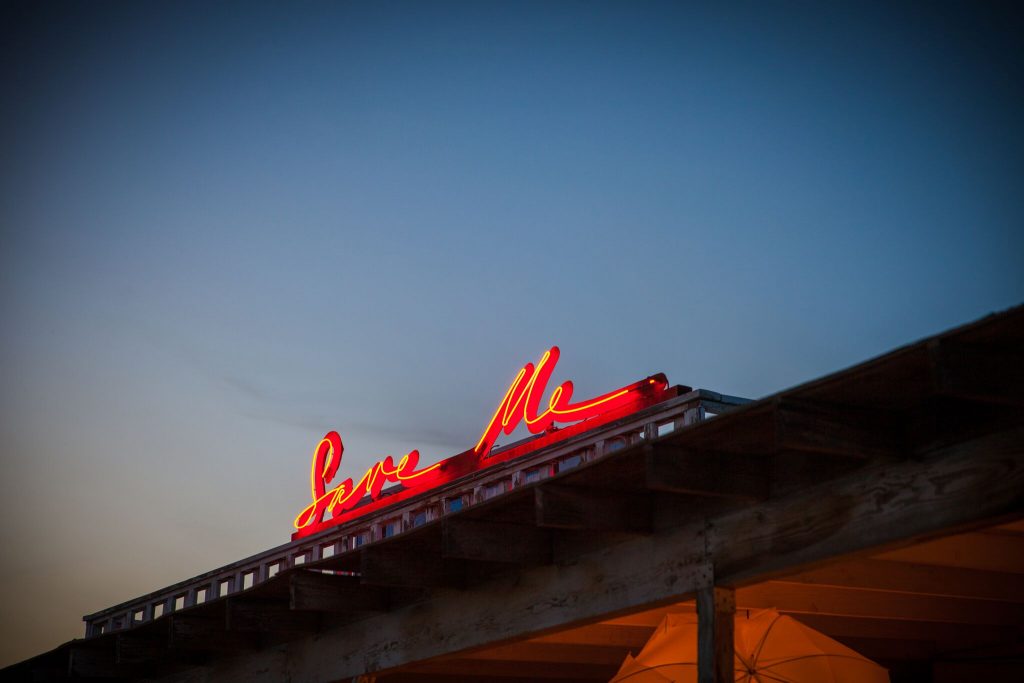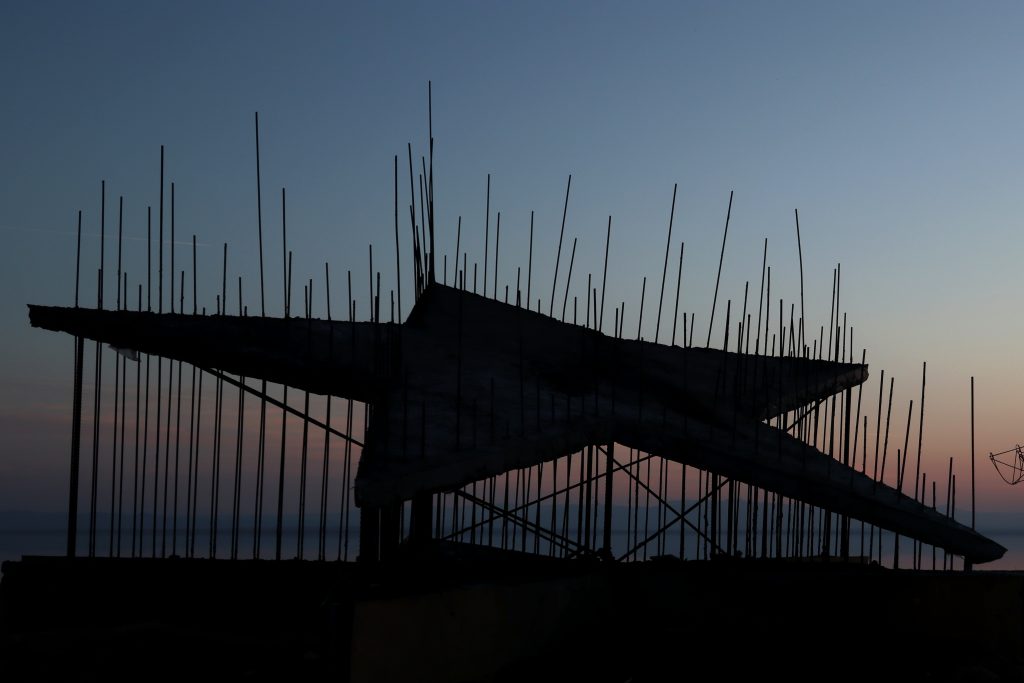Highlights From The 2019 Bombay Beach Biennale
An “art moment” turned “art movement” in the Southern California Desert

A small art movement is gaining momentum in Bombay Beach, just 40 miles from the Palm Springs area. The town is situated on the edge of the Salton Sea, California’s largest inland body of water. The Sea was created by accident in the early 1900s, when a levee broke on the Colorado River dam, causing an influx of water into the low-lying area. Post-war real estate speculators capitalized on this inland sea, calling it the “Miracle in the Desert,” and the “New American Riviera.” Yacht clubs, sport fishing marinas, and vacation homes sprung up along the shores, and for many decades, the Salton Sea was known as a desirable vacation destination.
As in all instances where humans imposes their will upon nature, things soon turned upside down. Pollutants from neighboring agricultural sites seeped into the sea, while evaporation caused the water to become more saline. Fish populations bloomed, and with no natural predators, quickly became unsustainable. As the sea lacked oxygen, fish then began to die off by the millions, resulting in a malodorous stench of death and decay that reached as far as Los Angeles. A rainy season and resulting flood in the late 1970s decimated many homes, with the community of Bombay Beach receiving the worst of the damage. Almost overnight, the area was left abandoned. Today, the detritus of the American Dream can be observed decaying on the shores of what has become a ticking-time-bomb of ecological disaster. Until recently, not many SoCal residents were aware of the sea, its history or its environmental significance.

“Las Flores del Valle,” photo by Barry Mulling
Fast forward to 2015: Lily White, Stefan Ashkenazy and Tao Ruspoli hatched a plan to raise awareness for the Salton Sea environmental crisis by producing an offbeat art happening in Bombay Beach, a near-ghost town with a population of fewer than 200 permanent residents. The ironically named Bombay Beach Biennale first took place in 2016 and has occurred annually since then, with the latest event commencing late in March. Renowned and emerging artists came together to create a surreal 72-hour experience that encompassed over 150 art installations, performances and musical acts. The event is always free to attend, entirely self-funded and led by a group of dedicated artists and friends who volunteer their time and talents to improving the small town.
We’re creating community over commodity
“This is not a festival,” states Biennale co-founder and immersive artist Stefan Ashkenazy. “It is a celebration for and by the people who have come to create lasting works in a town where we reside and/or frequent. The work created here is a reflection of the renegade nature of the town’s inhabitants and is imbued with the spirit of the artists that channel the innate freedom permeating Bombay Beach. Irony and juxtaposition provide unavoidable guidance. We are exploring a format for creative exchange where permanent works of art and sculpture come to life alongside a dying sea, as opposed to being choked to death in a gallery or museum inside a living city. We’re creating community over commodity.”

The yearly gathering serves as an “unveiling” of sorts for new permanent installations that are built to become part of the cultural fabric of the community. The artist group hopes that the ever-growing body of work will drive year-round tourist traffic and interest in the region, thus boosting the local economy and creating awareness for the plight of the Salton Sea. Cultural institutions including an opera house, drive-in movie theater, several museums, and many sculptural works are on view for anyone curious enough to make the trek.

“Part of my focus has been the development of institutions which one would expect in a large, vibrant city,” says Ashkenazy. “A hotel, museum, movie theater, opera house, a posh suburb and an amusement park. All of these are designed to play with the environment, poke fun at ourselves, and act as platforms for myself and other artists to explore what each of those institutions mean, both in Bombay (beyond the purview of convention) and well beyond its borders.”

New York City artist Greg Haberny has been involved in the Bombay Beach Biennale since its inception. Haberny was introduced to the Biennale by Ashkenazy, whose West Hollywood boutique hotel, Petit Ermitage, features an artist in residence program. The two collaborated on a concept for the first museum in Bombay Beach. The Hermitage Museum was launched in 2016 and transformed a derelict building into a world-class contemporary art space. The exhibition has grown each year and was re-named FOUNDATION FOUNDATION this year.

The current exhibition includes work by Greg Haberny, John Plypchuk, Bill Saylor, Timothy Uriah Steele, Steve Hash and Henry Vincent. Haberny is now a part-time resident of Bombay Beach and plans to continue creating work and developing the program at FOUNDATION FOUNDATION. Haberny explains, “My goal is to grant progressive artists from around the world a chance to explore the environmental wonders of Bombay Beach and to challenge themselves creatively by living and working in the town itself. It’s about paying it forward and giving other artists the opportunity that I was given.”

Also on permanent exhibition is the Bombay Beach Opera House, conceived by Ashkenazy as a performance space for classical opera and ballet. Ashkenazy invited San Francisco Ballet principal dancer Maria Kochetkova to grace the stage. She agreed upon one condition—that she chose the artist to design the space.

The result is a surreal sky blue building with an interior covered in thousands of flip-flops, the brainchild of British artist James Ostrer, who has returned annually to create new work for the space. The latest iteration includes several of Ostrer’s sculptural, multimedia, and photographic works. “I was breaking up with my life partner, immersed in my political art and not at all interested in helping making a backdrop for rich people to party in-front of,” says Ostrer. The opera house is flanked by the Bombay Beach Botanical Gardens, featuring a large-scale skeletal flower sculptural work by artist Yassi Mazandi.

Visitors to Bombay Beach who spend a little time exploring the town will discover many other treasures, including Randy Polumbo’s “Lodestar,” Kenny Scharf‘s “Bombay Boom—The Toy House,” many beachfront sculptural installations and the Bombay Beach Estates—an ironic take on a gated community twisted into a contemporary art park. Conceived and curated by Ashkenazy, the Estates include two museums, several gallery spaces, and many sculptural installations.

The Natural History Museum, located within the Bombay Beach Estates, features an artistic display of crystals, rare earth minerals, and dinosaur fossils arranged into an artistic display known as “DeXtinction” by NYC artist Carrie Schmidt. Neighboring interventions include Museum Number Two—“The World’s Shittiest Museum” by artist Moral Turgeman, “Happy Gallery” by LA-based artist Theodore Boyer, and “Naked Revelations”—a web-like display of undergarments and hand-written secrets collected by artist Moranne Layani and displayed in an all-black exhibition space.
“Year after year I drop everything to return to the edge of the civilization. Why? Well, this town exists as a platform where creation is truly boundless,” says Israeli artist Moral Turgeman, who has been creating work in Bombay Beach since 2016. “I feel proud to be a part of a collective with a mission to facilitate this cultural movement,” she continues. “This year, I transitioned my interventions from temporary to permanent.” Museum #2 is open to the public 24/7, and K-BAD 880FM, (the world’s smallest radio station) pops up from time to time for those curious enough to tune in.

Olivia Steele‘s neon piece “Save Me” illuminates the Bombay Beach Estates with a blood red glow. She has been creating work in the town every year since 2016 and believes the Biennale could help save the sea. “The production and installation of this piece hope to bring light to the cause as it gains urgency. The beauty of the Biennale is how the arts can affect meaningful change and jolt people out of complacency. ‘Save Me’ serves as both a celebration of—and a poignant call to action for—the forgotten paradise and the tragic ecological situation,” says Steele.

Adjacent to the Bombay Beach Estates, a sculpture garden, viewing platform, several gallery spaces, a polaroid museum, and artist residency program known as The Bombay Beach Institute of Particle Physics, Metaphysics, and International Relations anchors the corner of the town. The space is the brainchild of biennale co-founder and filmmaker Tao Ruspoli, who splits his time between Joshua Tree and Bombay Beach. The space is alive with green grass, animals and artists who take up residence for months or weeks at a time. Ruspoli leads the Academic Conference at the annual Biennale, which is programmed with lectures by illustrious philosophy professors such as Mark Wrathall, Christopher Ryan, Geoff Dyer and Sara Rubin.
The more we can embrace and foster these paradoxes and contradictions, the better
Ruspoli says, “I’ve always been attracted to the contractions that manifest in this place: It’s both ugly and beautiful, natural and unnatural (while the sea was formed by accident, it’s now an essential habitat for millions of fish and birds that depend on it), impoverished, yet rich with history and ongoing narratives of all kinds. Bombay Beach, when we started coming here, was both abandoned and full of the most colorful and eccentric characters. The list goes on, but my sense is the more we can embrace and foster these paradoxes and contradictions, the better. Hence the opera, the ballet, the academic conference, the formal gardens, the absurdly long names, the annual biannual, etc… All this helps provide fertile ground for artists and thinkers, who get to contemplate and delight in how different what they experience in Bombay Beach is from the otherwise mundane and homogenized and ultimately much more desolate landscape one finds in places like suburban America.”

Hidden away on the opposite corner of town, R.I.C.O. (The Research Institute for Contemporary Outlaws) has transformed two abandoned trailers into an exhibition titled, “The Fallen World.” The gallery and screening room offer an inside look at the rise of outlaw motorcycle clubs, the meaning of a misunderstood past, manhood, narrative, violence, aging, love and mid-20th century America. The exhibit showcases rare artifacts, film, and photography.

Now in its fifth year, The Bombay Beach Biennale has evolved from “Art Moment” to “Art Movement.” What was originally conceived as an annual event has transitioned into a year-round presence. Artists are buying homes, taking up residence, and revitalizing the town by transforming the abandoned buildings, vacant lots, and decaying shoreline into a living, breathing creative community. The full and part-time resident artists work with Bombay Beach locals to build and maintain artwork, activating the town with a constant flow of creation. The group has also undertaken a number of civil-service projects, including a trash and recycling program (the town was without any municipal waste collection), solar-powered street lighting, and a free meal program offered by the local community center.












